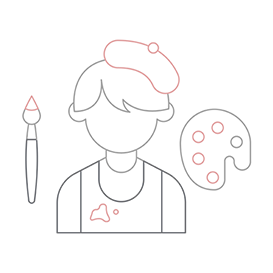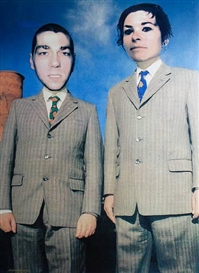Installation view, Summer Exhibition 2015 © David Parry.
The Royal Academy Summer Exhibition is a British tradition: as synonymous with the season as unpredictable weather, strawberries and cream, Wimbledon and bordeaux-color tans. It’s a bastion of the island’s eccentricity and love for prolonging bizarre customs, and their stoicism when it comes to the arts. The Summer Exhibition has taken place at Burlington House, London, every year without exception since 1769. Even during the First World War, in 1915, when the galleries were used by the United Arts Force – a voluntary alternative military effort comprised of a group of artists, architects, musicians and actors – the Summer Exhibition went up. During World War II the exhibition attracted 197,457 paying visitors.
In its early years, in the 18th century, the Summer Exhibition – known then simply as ‘the Exhibition’ – was the pinnacle of the annual arts calendar. Its primary focus was to display figurative painting, and works were submitted in standardized sizes, in gold frames, hung frame to frame, in hierarchical order, with the lesser known names below the more established artists. Gainsborough, Reynolds, Turner and Constable were among the first exhibitors.
Pierre et Gilles, Marie Antoinette, le hameau de la reine (Marie Antoinette, The Queen's Hamlet), 2014, Hand-painted photograph on canvas 154 x 139 cm, Photo courtesy of the artists and Galerie Daniel Templon, Paris, Brussels.
Evidently, a lot has changed in art terms since then, and artworks of every medium, including architectural models, video, and installation are now part of the mix, from experimental to conventional. The selection process, though, remains much unchanged. The invitation to entry is open to all, with a limit of 12,000 entries, submitted as digital images, then whittled down to a mere 4,000 works that are called in to be seen in the flesh by the ‘Hanging Committee’ (a rotating panel of Royal Academicians - artists elected to run the Royal Academy) who have selected 1,200 works for 2016’s exhibition -- all of which are for sale. The hanging of the work in itself adheres to a centuries-old tradition: Taking place over 8 days, the committee reportedly sips a secret brew of ‘beef tea’ that has been de rigueur since Turner’s day. The climax of it all is ‘Varnishing Day’—historically the final chance for artists to touch up their works. It was on this day that Turner and Constable had their infamous spat over their seascapes: Seeing that Constable’s seascape was more remarkable in color than his own, Turner marched up to his painting, Helvoetsluys, armed with a brush, and added a bright red buoy to the middle of the work. So what does the 248th year of this idiosyncratic event have in store?
This year,
Richard Wilson, renowned British sculptor and Royal Academician takes up the baton as coordinator, alongside his committee of fellow RA
artists Stephen Chambers, Louisa Hutton,
Bill Jacklin,
Jock McFadyen,
David Mach,
Cathie Pilkington,
David Remfry, Ian Ritchie and
Bill Woodrow. In addition to the selected public entries,
Wilson has invited artists whose work will be integrated throughout the galleries, so that world-renowned pieces might hang next to unknown works. Wilson’s focus for 2016 is artistic duos: He’s invited more than 15 pairs to present recent and new works. The RA itself doesn’t presently accept joint memberships, but Wilson has stated that his motive wasn’t political, but rather that the decision puts a spotlight on this mode of art making. Why do people pair up? How do they work together? How might working as a pair influence their thinking as artists? Whether familial, romantic, platonic, or simply professional, these are some of the questions these artists naturally pose through their practice as partners. In the age of living online, we are led to think of our activities as solitary and the creative process to be increasingly independent – Wilson’s Summer Exhibition reminds us that there is an inherent dynamism to working together—and that the particular results a double act can produce are compelling and often unexpected.

Tim Noble and Sue Webster, Forever (yellow), 2015, Enamelled aluminium, neon and LED lamps, 124.6 x 325.5 cm, Photo courtesy the artists and Blain|Southern. Photography: Peter Mallet.
Among the invited artists there are many who give insights into the duplicity of dualistic thinking; among them, Swiss duo Fischli/Weiss, known for picking at dualism, particularly in western ideology and popular iconography. On view at the RA is their six-minute looping video of a cat lapping milk, Busi (Kitty) (2001), originally commissioned for the NBC Astrovision screen at New York’s Time Square, where it played once again earlier this year as part of their retrospective at the Guggenheim. Rather than a cutting commentary on contemporary kitsch, the artists’ aim reverses typical expectations: Among the garish advertisements, the quiet amateurish video surprisingly stands out - a contemplation of the known with heightened consciousness.
Among the other duos in dialogue with the nature of dualism is the award-winning Singh Twins, identical twin sisters Amrit and Rabindra with a dual heritage – British and Indian. Their work interweaves the personal and the political, ancient and modern, traditional and transgressive, East and West – proving the impossibility of viewing opposites as separate and challenging the ideal of individuality. “We haven’t felt the need to go separate ways or stress our individuality.” The sisters say, in an interview with Fiona Maddocks for the RA. “As children, we were given the same creative opportunities – often drawing and painting together – and we shared the same education and life experiences. So perhaps, there was a certain inevitability to our artistic partnership.” Included in the exhibition is their work London’s Burning: Read All About It, exploring famous fires in the capital, from the Gunpowder Plot to the 2011 riots.

Boyd & Evans, Tonopah NV, 2015, Archival pigment print, 110x110 cm, Photo © Boyd & Evans, courtesy of Flowers Gallery London and New York.
Other well-known sibling duos included are YBAs Jack & Dinos Chapman, (who are unveiling a major new work as part of the exhibition, a rare participation in a group show for the brothers) and twin sisters Jane and Louise Wilson, who explain “when two artists work together as one, actively looking for that space to oppose the orthodoxy of the single artistic ego.” Among the other acclaimed names are husband and wife of 50 years, Boyd & Evans; Allora & Calzadilla, (who began working together in the 90s having met while studying in Florence), and Berlin-based Eva & Adele (you’ll recognize them when you see them, if you’ve been at any art fair around the world in the last ten years) who consider their life together as a couple their artwork: The gender-queer artistic couple dress in identical theatrical clothes, wear the same make-up, eat the exact same foods, and have reportedly never spent a night apart in more than 22 years together. They do not disclose their real names or ages as they claim to have landed in Berlin in ‘time machines’ after the wall fell.

EVA & ADELE, Transformer-Performer Double-Act VIII, 2015, Mixed media on canvas, 208 x 308 cm, Photo courtesy of Nicole Gnesa Gallery.
Though it only represents a fraction of what there is to see at the Summer Exhibition in 2016, Wilson’s focus on artist duos is an opportunity for a timely contemplation of the wider concepts of sharing ideas and collaborative creativity. As he states in an interview for the RA: “In the past, too, most of the great artists had assistants and workshops. We cannot know exactly who did what. It challenges the idea of artists working in isolation and begs the question, “Can good art only come from a single artist working alone?” I certainly believe in the collective consciousness, the shared experience.”



























